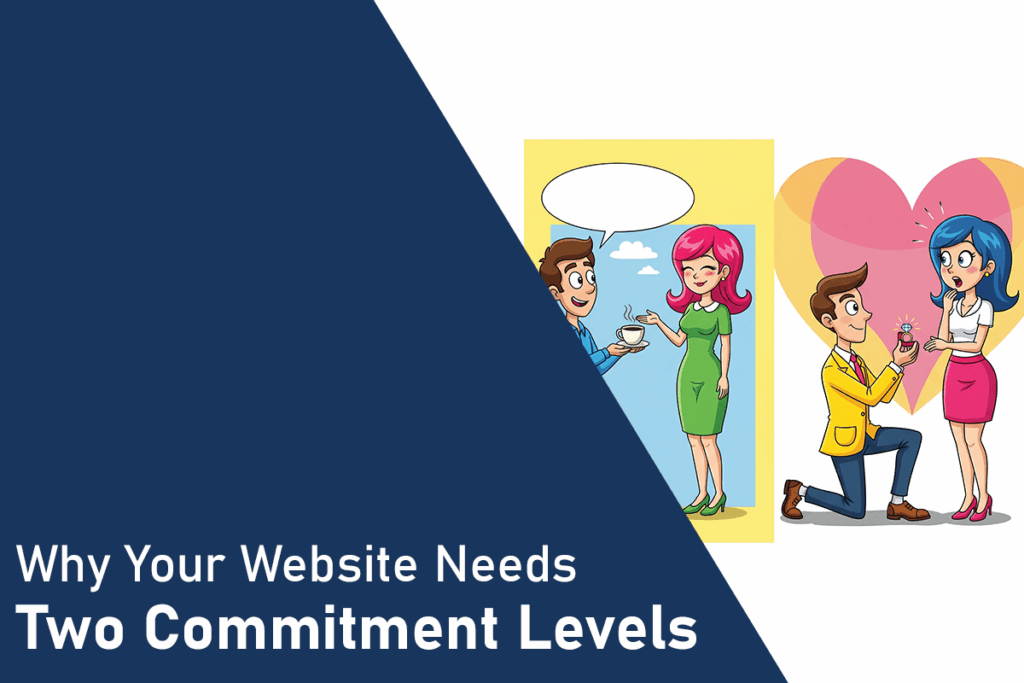“Marry Me” vs “Coffee Date”: Why You Need Two Commitment Levels on Your Website

You would never ask a person to marry you within the first few minutes of meeting them. This is considered socially unacceptable and would likely not produce the desired outcome (and it would get you a weird look!). It’s much more socially acceptable to ask for a coffee date. By getting a small “yes”, you can invest in a further level of commitment over time.
This dynamic applies to business relationships. One topic we discuss internally at Bluestem Media and with our clients is the importance of having multiple commitment levels for website visitors.
Fact: Most website visitors will never take an action. The more expensive or complex your product/service is, the lower the conversion rate. This is one of the most frustrating parts of working in digital marketing: we can never convert 100% of web traffic to paying customers.
We can improve the likelihood that a website visitor gives us a piece of personal information by lowering the stakes. Instead of asking them to purchase a $250 product, we can ask if they want to download a free coupon for 20% off a product (with an email exchange, of course). By gaining this information, we can “remarket” this email address later and ask them to purchase at an appropriate time.
While the “marry me” vs “coffee date” analogy doesn’t map perfectly onto potential business relationships and customer leads, it’s a good heuristic for creating multiple customer commitment levels.
Website Content
What is “Coffee Date” content?
It’s good to have different types of content on your business website. If all content is exclusively focused on your services, it tends to fall into the “marry me” category rather than the “coffee date” category. You should consider creating infographics, blog posts, videos, and resource sections on your website that are related to your services, but provide standalone help on the topic. If you are a plumber, you can film a YouTube video on how to keep pipes from freezing in the winter. This video will have no commercial value to you as a business owner; you are offering free help. However, this builds your base of trust and authority, and in the right circumstances, moves a customer further down in the sales funnel.
If a YouTube viewer trusts you on preventing frozen pipes, they view you as an authority in the industry. It stands to reason they are likely to trust you with a plumbing repair in their home.
Examples of “coffee date” content for a website:
- How-to videos and articles
- Free calculators (these work great in the finance/mortgage space)
- eBook downloads
- Glossary sections/articles on industry topics
- Webinars
- Infographics that simplify a complex topic in your industry
- About & Team pages
What is “Marry Me” content?
If a dating relationship is going well, it’s reasonable to take the next action: asking for marriage.
If you are asking to do business with a website visitor, this is considered “marry me” content. This can look like a product page with an “add to cart” button. It can be a page that describes your services, and has a “request a quote” web form.
Examples of “marry me” content for a website:
- Service pages
- Product information pages
- Landing pages
- Traditional website contact forms
If you have a website with just “coffee date” content, but no “marry me” content, you will never sell any products or services. So, it’s essential that your service pages, landing pages, and product pages have a strong offer and an easy way for customers to convert.
Calls-to-Action
“Coffee date” and “marry me” also apply to calls-to-action on your website. A call-to-action is a button, form, or link that asks a website visitor to either contact you or give you their information.
What is “Coffee Date” call-to-action?
Any call-to-action that has a very low level of commitment or has basic inputs is considered a “coffee date” call-to-action.
Examples:
- Email newsletter signup
- Free eBook download signup form
- Quizzes
- “Enter to win” giveaway contests
- AI or human-staffed web chatbots
Website visitors should be given the opportunity to fill out a webform that requires very little commitment on their end, likely just an email address. They exchange a small piece of information for something valuable in return.
The offer must be valuable. I’ve seen many brands create a generic “sign up for our monthly newsletter” web form and then wonder why they have had zero signups in 8-12 months. The reason is that the user did not see enough value in what you are producing to give away their email address.
When you have a strong offer, you will get more email addresses.
What is “Marry Me” call to action?
A “marry me” call-to-action is a direct ask from your business to a potential customer to Buy Now or request a quote for services. If they take this next step, the visitor is serious. Ninety percent of the sales process has been completed at this point, you just need to finalize the deals or close the sale. The customer is confident in your ability to handle their needs and trusts that you can deliver.
Examples of “Marry Me” calls to action:
- Contact page contact form
- “Get a Quote” form
- Product page buy now button
- Checkout page
- Phone call
By the time a user arrives at this point, they’ve consumed enough “coffee date” and “marry me” content on your website to be comfortable doing business with you. This is the massive upside to having a website: it moves customers through the sales funnel passively, without a salesman having to walk them through each step.
Implementing the Two-Level Commitment Approach
We’ve covered the theory of “coffee date” versus “marry me” commitment levels. But how do you practically implement both types of commitment levels on a website?
My implementation strategy contradicts my analogy (like I said, it’s not a perfect analogy). You should start by building your “marry me” content and calls-to-action first. Build your home page, your service pages, list your products, and develop all your web forms. Sure, this will have a lower conversion rate than “coffee date” content and calls-to-action. But it’s the core bread and butter of your business. It’s important to build the systems that will help you generate cash flow.
Once you have a strong “marry me” pitch, you can start building “coffee date” content and calls-to-action. Start writing blog posts, filming how-to YouTube videos, and building an email list. Find ways to finesse a piece of contact information from the visitor. They may not be willing to fill out a traditional contact form, but they are willing to exchange a throwaway email for a free eBook. Then, you can create an entire campaign around converting this visitor to a paid customer using email marketing. It won’t work every time, but it does work.
Faster & Slower
Not every customer or website visitor is the same. Some will spend weeks clicking through dozens of pages, bookmarking your content, and will finally reach out to you. Others will visit your website’s homepage, call your listed phone number immediately, and request services. It really depends on the motivation of the user and what type of service/product you offer.
The key is to have content and calls-to-action at both commitment levels. You want the user to feel comfortable moving between both levels and taking the action that feels best. Since the content, messaging, and calls-to-action are hosted passively on your website, you can let the system do the heavy lifting.
Wrapping Up
I would recommend implementing two commitment levels on your website. This will take some time to develop, but over time, your website will have a nice mix of “coffee date” and “marry me” content. Not all web traffic is ready to do business right away. Sometimes, they need to trust you as an authority in your industry before they are willing to trust you with their cash. By creating content and calls-to-action in both realms, you will give a website visitor the best chance of converting.
If you want to upgrade your current website or build one for the first time, reach out to us!
Isaac Wiinanen
Isaac is an SEO Strategist & Web Project Lead for Bluestem Media. Focused on local SEO, Google Business Profile optimization, and StoryBrand marketing.

